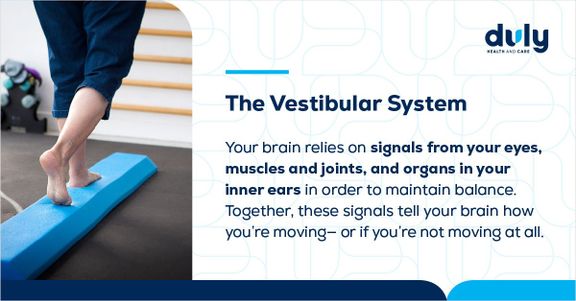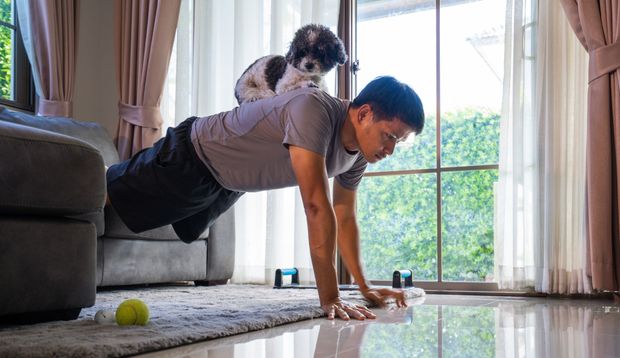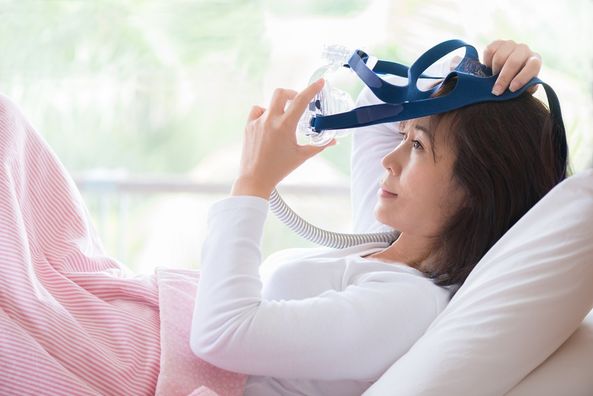You feel like you’re seasick. You’re nauseated and dizzy, and you’re having trouble keeping your balance. But there’s one major problem with this: You’re not actually at sea!
That feeling of imbalance, even when you’re just standing still or walking down the sidewalk, could be a sign of a vestibular disorder. And you might be surprised to know that your inner ears are very much to blame for the dizziness.
The Vestibular System: The Connection Between Ears and Balance
Your ears do more than help you hear. A lot more.
The parts in your inner ear work with your brain to help maintain balance and control eye movement. This is your vestibular system.

Source: Vestibular Disorders Association (VeDA)
If the vestibular system is weak or damaged, it can lead to a vestibular disorder. Damage could come from an injury or structural problems in the ear. For example, there are small crystals (otoconia) within your inner ear that are sensitive to gravity and acceleration. They usually rest in the part called the utricle. Sometimes, these inner ear crystals shift into your ear’s semicircular canals. When the crystals are out of place, they can make you sensitive to changes in your body position or movements that you wouldn’t usually be sensitive to, causing a spinning sensation (vertigo). This vertigo is often associated with getting in/out of your bed.
Fortunately, vestibular rehabilitation therapy (VRT) can make a difference if you are experiencing these symptoms.
Where Vestibular Rehabilitation Therapy Comes In
Vestibular rehabilitation therapy is a specialized, exercise-based treatment plan that aims to help you manage and cope with symptoms, such as:
- Dizziness
- Vertigo (Feeling like you are spinning or moving when you’re not actually doing so, or feeling like your surroundings are spinning)
- Disequilibrium (Feeling unsteady, imbalanced, or disoriented)
- Falling
- Nausea
- Headaches
- Visual problems, like blurred vision
- Motion sickness
- Difficulty moving and walking around
VRT is particularly beneficial if you have:
- Benign paroxysmal positional vertigo (BPPV), which causes temporary, intense episodes of vertigo that are typically triggered by your head changing position. It occurs when your inner ear crystals shift out of their normal position within the ear.
- Vestibular neuritis/labyrinthitis, which is inflammation of the nerve that carries signals from your vestibular organs to the brain. It causes sudden and severe episodes of vertigo, as well as nausea and vomiting.
- Post-concussion syndrome, which occurs when your vestibular system is damaged due to a traumatic brain injury. This damage can cause your system to send inaccurate information to your brain, resulting in imbalance, dizziness, head or neck pain, difficulty concentrating, or whiplash.
VRT can also be used to treat imbalance or dizziness caused by other conditions, such as stroke.
If you are having imbalance, dizziness, or vertigo, vestibular rehabilitation therapy may be right for you. Contact a Duly vestibular physical therapist to learn how you could benefit from VRT.
What to Expect During VRT
The first step is meeting with a physical therapist who specializes in vestibular rehabilitation to discuss your symptoms and have your vestibular system evaluated. During this initial evaluation, your therapist may perform muscle strength or balance screenings (like having you stand in certain positions and maintain them without losing your balance), and will observe your eye movements.
Next, your therapist will prescribe how often you should go to physical therapy and which types of exercise to focus on.
Depending on your symptoms and the specific disorder causing your imbalance, you may be prescribed exercises such as:
- Canalith repositioning procedure: This is used to treat benign paroxysmal positional vertigo (BPPV). It involves clearing the inner ear crystals (small pieces of calcium bicarbonate) that have broken off and are floating in your inner ear canal with specific head and body movements.
- The Epley maneuver: This is a specific type of canalith repositioning procedure to treat the posterior canal (the most commonly affected canal).
- Gaze stabilization: This improves your eye movements so that your vision can remain clear when you move your head. Your eyes coordinate with your inner ear to maintain your equilibrium. You may need to do gaze stabilization exercises if you can’t see clearly because things seem to jump about or bounce, especially as you’re moving.
- Balance training: This type of training aims to improve unsteadiness, sharpen reflexes and keep you on your feet.
- Strengthening and postural exercises: These are designed to improve body strength, flexibility, and posture — all of which can be impacted if you don’t move very often in an effort to avoid getting dizzy.
Also, read 4 Surprising Things You Didn’t Know You Could Go to Physical Therapy For
As for how long and how often you will need to attend VRT? There isn’t a clear-cut answer. Depending on the root cause of your symptoms, you could notice improvement after a few days or several weeks.
Even if it seems like it’s taking a long time to notice any improvement, stick with it. It might be frustrating and time-consuming at the moment, but your body and inner ears will thank you in the long run.
Health Topics:








